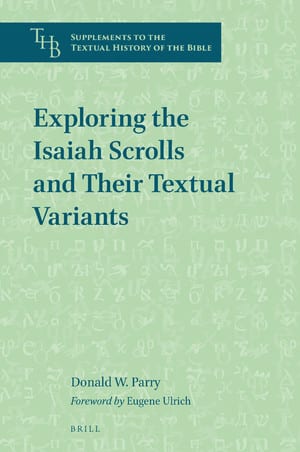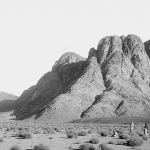
My long-time friend and FARMS and departmental colleague Don Parry has a new book out with E. J. Brill Publishing in the Netherlands:
In Exploring the Isaiah Scrolls and Their Textual Variants, Donald W. Parry systematically presents, on a verse-by-verse basis, the variants of the Hebrew witnesses of Isaiah (the Masoretic Text and the twenty-one Isaiah Dead Sea Scrolls) and briefly discusses why each variant exists. The Isaiah scrolls have greatly impacted our understanding of the textual history of the Bible, and in recent decades, Bible translation committees have incorporated a number of the variants into their translations; as such, the Isaiah scrolls are important for both academic and popular audiences. Variant characterizations include four categories: (a) accidental errors, e.g., dittography, haplography, metathesis, graphic similarity; (b) intentional changes by scribes and copyists; (c) synonymous readings; (d) scribes’ stylistic approaches and conventions.
In his “Foreword” to the book, Professor Eugene Ulrich of the University of Notre Dame has some very kind things to say about Don and his work. Here’s a portion of them:
Donald Parry—combining the promise offered by the Dead Sea Scrolls with the richness of the book of Isaiah—has provided in this volume both a highly useful compendium of the Hebrew textual variants of the book of Isaiah and, more broadly, a veritable handbook on textual criticism.
The book of Isaiah exhibits the entire bewildering gamut of possible textual complexities.
Parry surveys, verse by verse throughout the sixty-six chapters of Isaiah, all the textual variants in the MT, the fully preserved Scroll (1QIsaa), and any of the other Hebrew witnesses of Isaiah. For each variant he lists the readings of the MT and any preserved Hebrew Scrolls, and then offers a discussion, drawing on a wide selection of scholars who have offered differing arguments concerning the cause and the preferability of the variants. Additionally, he includes divergent readings derived from citations of Isaiah in the nonbiblical Scrolls: the pesharim and the community’s religious compositions.
No two scholars would agree regarding all judgments contained in any large collection of textual variants, and not all would endorse every judgment presented here. Parry, of course, acknowledges the “subjectivity” involved, but that subjectivity is controlled by the theories and rules that constrain text-critical practice. What is important is that a scholar honestly attempt a nonbiased judgment that is reasonable, informed, and judicious.
Taking advantage of the rapidly advancing world of technology a decade after the completion of the editio princeps maior in Discoveries in the Judaean Desert, Parry has made use of electronic resources, computerized search programs, and especially, through cooperation with his colleague Steve Booras, multispectral imaging. This technology—not available even about a decade ago—makes possible a magnified and clearer vision of the Qumran fragments and damaged letters, which helps determine a more accurate reading of the fragments.
This volume is the fruit of decades of study of Isaiah and other Scrolls by Parry, and the result is a rich resource of carefully arranged and presented material for analysis of the most, or one of the most, important and instructive manuscripts from antiquity.












